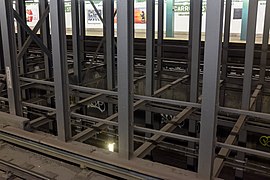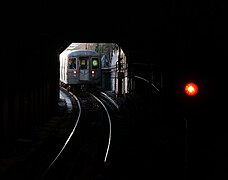The IND Culver Line is a rapid transit line of the B Division of the New York City Subway, extending from Downtown Brooklyn south to Coney Island, Brooklyn, New York City, United States. The local tracks of the Culver Line are served by the F service, as well as the G between Bergen Street and Church Avenue. The express tracks north of Church Avenue are used by the <F> train during rush hours in the peak direction. The peak-direction express track between Ditmas Avenue and Avenue X has not seen regular service since 1987.
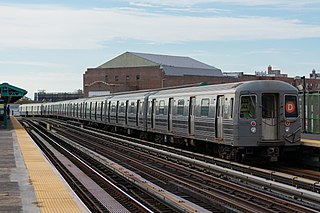
The D Sixth Avenue Express is a rapid transit service in the B Division of the New York City Subway. Its route emblem, or "bullet", is colored orange, since it uses the IND Sixth Avenue Line in Manhattan.

The F and <F> Queens Boulevard Express/Sixth Avenue Local are two rapid transit services in the B Division of the New York City Subway. Their route bullets are colored orange, since they use and are part of the IND Sixth Avenue Line in Manhattan.

The Church Avenue station is an express station on the IND Culver Line of the New York City Subway. Located at Church and McDonald Avenues in Kensington, Brooklyn, it is served by the F and G trains at all times, and by the <F> train during rush hours in the peak direction.

The Bergen Street station is a station on the IND Culver Line of the New York City Subway, located at the intersection of Bergen Street and Smith Street on the border of Cobble Hill and Boerum Hill in Brooklyn. It is served by the F and G trains at all times.

The Kings Highway station is an express station on the IND Culver Line of the New York City Subway, located at Kings Highway and McDonald Avenue in the Gravesend neighborhood of Brooklyn. The station is served by the F train at all times and the <F> train during rush hours in the peak direction.
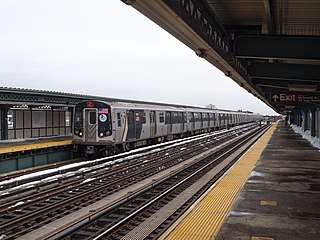
The Avenue N station is a local station on the IND Culver Line of the New York City Subway, located at the intersection of Avenue N and McDonald Avenue in Brooklyn. It is served by the F train at all times and the <F> train during rush hours in the peak direction.

The Seventh Avenue station is an express station on the IND Culver Line of the New York City Subway, located at Seventh Avenue and Ninth Street in the Park Slope neighborhood of Brooklyn. It is served by the F and G trains at all times, and by the <F> train during rush hours in the peak direction.
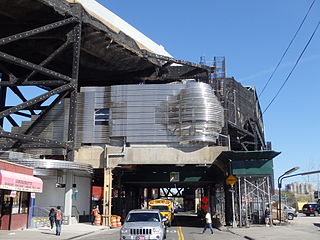
The Smith–Ninth Streets station is a local station on the IND Culver Line of the New York City Subway. It is located over the Gowanus Canal near the intersection of Smith and Ninth Streets in Gowanus, Brooklyn, and is served by the F and G trains at all times. The station is 87.5 feet (26.7 m) above ground level and was formerly the highest rapid transit station in the world.

The West Eighth Street–New York Aquarium station is a New York City Subway station, located on the BMT Brighton Line and IND Culver Line in the Coney Island neighborhood of Brooklyn. The station is located over the private right-of-way of the defunct New York and Coney Island Railroad north of Surf Avenue, running easterly from West 8th Street. It is served by the F and Q trains at all times, and by the <F> train during rush hours in the peak direction. This station is geographically the southernmost station in the entire New York City Subway system.

The Ditmas Avenue station is a local station on the IND Culver Line of the New York City Subway. Located at the intersection of Ditmas and McDonald Avenues in Kensington, Brooklyn, it is served by the F train at all times and the <F> train during rush hours in the peak direction.

The Avenue P station is a local station on the IND Culver Line of the New York City Subway. It is served by the F train at all times and the <F> train during rush hours in the peak direction.

The Avenue I station is a local station on the IND Culver Line of the New York City Subway. Located at the intersection of Avenue I and McDonald Avenue in Midwood, Brooklyn, it is served by the F train at all times and the <F> train during rush hours in the peak direction.

The 15th Street–Prospect Park station is a local station on the IND Culver Line of the New York City Subway. Located at 15th Street east of Prospect Park West in the Windsor Terrace and Park Slope neighborhoods in Brooklyn, it is served by the F and G trains at all times.

The Fort Hamilton Parkway station is a local station on the IND Culver Line of the New York City Subway. It is served by the F and G trains at all times.
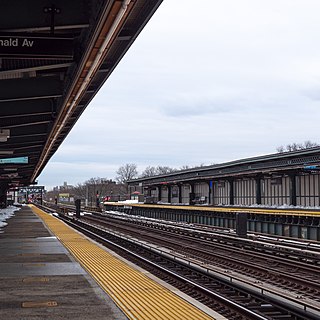
The Avenue U station is a local station on the IND Culver Line of the New York City Subway, located at the intersection of Avenue U and McDonald Avenue in Gravesend, Brooklyn. It is served by the F train at all times and the <F> train during rush hours in the peak direction.

The Avenue X station is a local station in Brooklyn on the IND Culver Line of the New York City Subway. It is served by the F train at all times and the <F> train during rush hours in the peak direction.

The Neptune Avenue station is a station on the IND Culver Line of the New York City Subway, located in Coney Island, Brooklyn, at the intersection of Neptune Avenue and West 6th Street. It is served by the F train at all times and the <F> train during rush hours in the peak direction.

The Fourth Avenue/Ninth Street station is a New York City Subway station complex shared by the elevated IND Culver Line and the underground BMT Fourth Avenue Line. It is located at the intersection of Ninth Street and Fourth Avenue in Park Slope, Brooklyn and served by the:

The Jay Street–MetroTech station is a New York City Subway station complex on the IND Fulton Street, IND Culver, and BMT Fourth Avenue lines. The complex is located in the vicinity of MetroTech Center in Downtown Brooklyn. It is served by the A, F, and R trains at all times; the C train at all times except late nights; the N train during late nights only; and a few rush-hour W and <F> trains in the peak direction.








